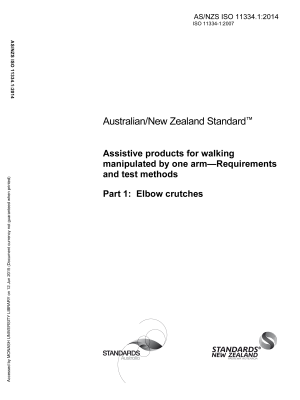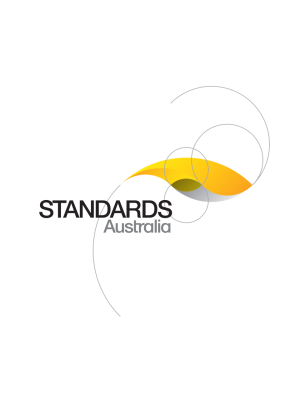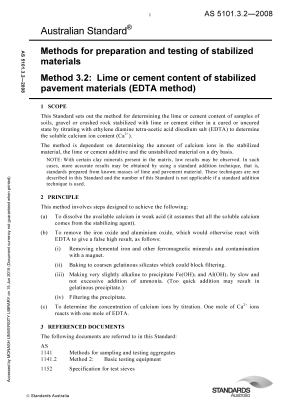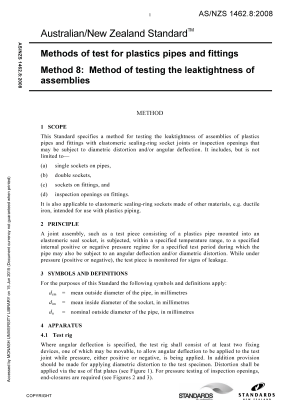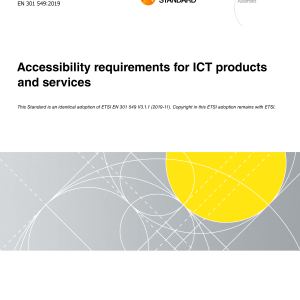🔍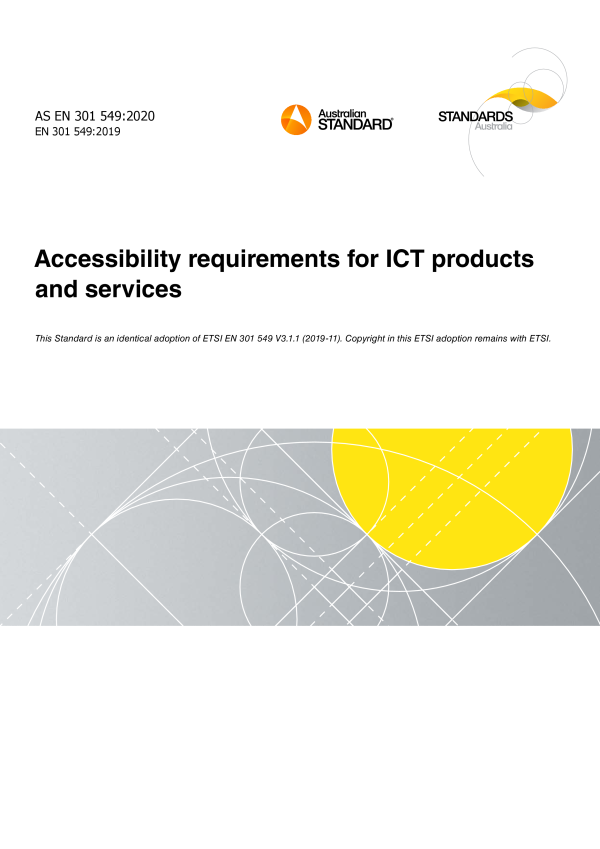

Purchase the full subscription package now and enjoy a 40% discount, along with free updates for future editions.
AS EN 301 549:2020
$12.33
Accessibility requirements for ICT products and services
This Standard adopts EN 301 549:2019 (V3.1.1), which specifies the functional accessibility requirements applicable to ICT products and services, together with a description of the test procedures and evaluation methodology for each accessibility requirement in a form that is suitable for use in public procurement within Australia.
Table of contents
Header
About this publication
Preface
Intellectual Property Rights
Foreword
Modal verbs terminology
Introduction
1 Scope
2 References
2.1 Normative references
2.2 Informative references
3 Definition of terms, symbols and abbreviations
3.1 Terms
3.2 Symbols
3.3 Abbreviations
4 Functional performance
4.1 Meeting functional performance statements
4.2 Functional performance statements
4.2.1 Usage without vision
4.2.2 Usage with limited vision
4.2.3 Usage without perception of colour
4.2.4 Usage without hearing
4.2.5 Usage with limited hearing
4.2.6 Usage with no or limited vocal capability
4.2.7 Usage with limited manipulation or strength
4.2.8 Usage with limited reach
4.2.9 Minimize photosensitive seizure triggers
4.2.10 Usage with limited cognition, language or learning
4.2.11 Privacy
5 Generic requirements
5.1 Closed functionality
5.1.1 Introduction (informative)
5.1.2 General
5.1.2.1 Closed functionality
5.1.2.2 Assistive technology
5.1.3 Non-visual access
5.1.3.1 Audio output of visual information
5.1.3.2 Auditory output delivery including speech
5.1.3.3 Auditory output correlation
5.1.3.4 Speech output user control
5.1.3.5 Speech output automatic interruption
5.1.3.6 Speech output for non-text content
5.1.3.7 Speech output for video information
5.1.3.8 Masked entry
5.1.3.9 Private access to personal data
5.1.3.10 Non-interfering audio output
5.1.3.11 Private listening volume
5.1.3.12 Speaker volume
5.1.3.13 Volume reset
5.1.3.14 Spoken languages
5.1.3.15 Non-visual error identification
5.1.3.16 Receipts, tickets, and transactional outputs
5.1.4 Functionality closed to text enlargement
5.1.5 Visual output for auditory information
5.1.6 Operation without keyboard interface
5.1.6.1 Closed functionality
5.1.6.2 Input focus
5.1.7 Access without speech
5.2 Activation of accessibility features
5.3 Biometrics
5.4 Preservation of accessibility information during conversion
5.5 Operable parts
5.5.1 Means of operation
5.5.2 Operable parts discernibility
5.6 Locking or toggle controls
5.6.1 Tactile or auditory status
5.6.2 Visual status
5.7 Key repeat
5.8 Double-strike key acceptance
5.9 Simultaneous user actions
6 ICT with two-way voice communication
6.1 Audio bandwidth for speech
6.2 Real-Time Text (RTT) functionality
6.2.1 RTT provision
6.2.1.1 RTT communication
6.2.1.2 Concurrent voice and text
6.2.2 Display of RTT
6.2.2.1 Visually distinguishable display
6.2.2.2 Programmatically determinable send and receive direction
6.2.2.3 Speaker identification
6.2.2.4 Visual indicator of Audio with RTT
6.2.3 Interoperability
6.2.4 RTT responsiveness
6.3 Caller ID
6.4 Alternatives to voice-based services
6.5 Video communication
6.5.1 General (informative)
6.5.2 Resolution
6.5.3 Frame rate
6.5.4 Synchronization between audio and video
6.5.5 Visual indicator of audio with video
6.5.6 Speaker identification with video (sign language) communication
6.6 Alternatives to video-based services
7 ICT with video capabilities
7.1 Caption processing technology
7.1.1 Captioning playback
7.1.2 Captioning synchronization
7.1.3 Preservation of captioning
7.1.4 Captions characteristics
7.1.5 Spoken subtitles
7.2 Audio description technology
7.2.1 Audio description playback
7.2.2 Audio description synchronization
7.2.3 Preservation of audio description
7.3 User controls for captions and audio description
8 Hardware
8.1 General
8.1.1 Generic requirements
8.1.2 Standard connections
8.1.3 Colour
8.2 Hardware products with speech output
8.2.1 Speech volume gain
8.2.1.1 Speech volume range
8.2.1.2 Incremental volume control
8.2.2 Magnetic coupling
8.2.2.1 Fixed-line devices
8.2.2.2 Wireless communication devices
8.3 Stationary ICT
8.3.0 General
8.3.1 Forward or side reach
8.3.2 Forward reach
8.3.2.1 Unobstructed high forward reach
8.3.2.2 Unobstructed low forward reach
8.3.2.3 Obstructed forward reach
8.3.2.3.1 Clear space
8.3.2.3.2 Obstructed (< 510 mm) forward reach
8.3.2.3.3 Obstructed (< 635 mm) forward reach
8.3.2.4 Knee and toe clearance width
8.3.2.5 Toe clearance
8.3.2.6 Knee clearance
8.3.3 Side reach
8.3.3.1 Unobstructed high side reach
8.3.3.2 Unobstructed low side reach
8.3.3.3 Obstructed side reach
8.3.3.3.1 Obstructed (≤ 255 mm) side reach
8.3.3.3.2 Obstructed (≤ 610 mm) side reach
8.3.4 Clear floor or ground space
8.3.4.1 Change in level
8.3.4.2 Clear floor or ground space
8.3.4.3 Approach
8.3.4.3.1 General
8.3.4.3.2 Forward approach
8.3.4.3.3 Parallel approach
8.3.5 Visibility
8.3.6 Installation instructions
8.4 Mechanically operable parts
8.4.1 Numeric keys
8.4.2 Operation of mechanical parts
8.4.2.1 Means of operation of mechanical parts
8.4.2.2 Force of operation of mechanical parts
8.4.3 Keys, tickets and fare cards
8.5 Tactile indication of speech mode
9 Web
9.0 General (informative)
9.1 Perceivable
9.1.1 Text alternatives
9.1.1.1 Non-text content
9.1.2 Time-based media
9.1.2.1 Audio-only and video-only (pre-recorded)
9.1.2.2 Captions (pre-recorded)
9.1.2.3 Audio description or media alternative (pre-recorded)
9.1.2.4 Captions (live)
9.1.2.5 Audio description (pre-recorded)
9.1.3 Adaptable
9.1.3.1 Info and relationships
9.1.3.2 Meaningful sequence
9.1.3.3 Sensory characteristics
9.1.3.4 Orientation
9.1.3.5 Identify input purpose
9.1.4 Distinguishable
9.1.4.1 Use of colour
9.1.4.2 Audio control
9.1.4.3 Contrast (minimum)
9.1.4.4 Resize text
9.1.4.5 Images of text
9.1.4.6 Void
9.1.4.7 Void
9.1.4.8 Void
9.1.4.9 Void
9.1.4.10 Reflow
9.1.4.11 Non-text contrast
9.1.4.12 Text spacing
9.1.4.13 Content on hover or focus
9.2 Operable
9.2.1 Keyboard accessible
9.2.1.1 Keyboard
9.2.1.2 No keyboard trap
9.2.1.3 Void
9.2.1.4 Character key shortcuts
9.2.2 Enough time
9.2.2.1 Timing adjustable
9.2.2.2 Pause, stop, hide
9.2.3 Seizures and physical reactions
9.2.3.1 Three flashes or below threshold
9.2.4 Navigable
9.2.4.1 Bypass blocks
9.2.4.2 Page titled
9.2.4.3 Focus Order
9.2.4.4 Link purpose (in context)
9.2.4.5 Multiple ways
9.2.4.6 Headings and labels
9.2.4.7 Focus visible
9.2.5 Input modalities
9.2.5.1 Pointer gestures
9.2.5.2 Pointer cancellation
9.2.5.3 Label in name
9.2.5.4 Motion actuation
9.3 Understandable
9.3.1 Readable
9.3.1.1 Language of page
9.3.1.2 Language of parts
9.3.2 Predictable
9.3.2.1 On focus
9.3.2.2 On input
9.3.2.3 Consistent navigation
9.3.2.4 Consistent identification
9.3.3 Input assistance
9.3.3.1 Error identification
9.3.3.2 Labels or instructions
9.3.3.3 Error suggestion
9.3.3.4 Error prevention (legal, financial, data)
9.4 Robust
9.4.1 Compatible
9.4.1.1 Parsing
9.4.1.2 Name, role, value
9.4.1.3 Status messages
9.5 WCAG 2.1 AAA Success Criteria
9.6 WCAG conformance requirements
10 Non-web documents
10.0 General (informative)
10.1 Perceivable
10.1.1 Text alternatives
10.1.1.1 Non-text content
10.1.2 Time-based media
10.1.2.1 Audio-only and video-only (pre-recorded)
10.1.2.2 Captions (pre-recorded)
10.1.2.3 Audio description or media alternative (pre-recorded)
10.1.2.4 Captions (live)
10.1.2.5 Audio description (pre-recorded)
10.1.3 Adaptable
10.1.3.1 Info and relationships
10.1.3.2 Meaningful sequence
10.1.3.3 Sensory characteristics
10.1.3.4 Orientation
10.1.3.5 Identify input purpose
10.1.4 Distinguishable
10.1.4.1 Use of colour
10.1.4.2 Audio control
10.1.4.3 Contrast (minimum)
10.1.4.4 Resize text
10.1.4.5 Images of text
10.1.4.6 Void
10.1.4.7 Void
10.1.4.8 Void
10.1.4.9 Void
10.1.4.10 Reflow
10.1.4.11 Non-text contrast
10.1.4.12 Text spacing
10.1.4.13 Content on hover or focus
10.2 Operable
10.2.1 Keyboard accessible
10.2.1.1 Keyboard
10.2.1.2 No keyboard trap
10.2.1.3 Void
10.2.1.4 Character key shortcuts
10.2.2 Enough time
10.2.2.1 Timing adjustable
10.2.2.2 Pause, stop, hide
10.2.3 Seizures and physical reactions
10.2.3.1 Three flashes or below threshold
10.2.4 Navigable
10.2.4.1 Void
10.2.4.2 Document titled
10.2.4.3 Focus Order
10.2.4.4 Link purpose (in context)
10.2.4.5 Void
10.2.4.6 Headings and labels
10.2.4.7 Focus visible
10.2.5 Input modalities
10.2.5.1 Pointer gestures
10.2.5.2 Pointer cancellation
10.2.5.3 Label in name
10.2.5.4 Motion actuation
10.3 Understandable
10.3.1 Readable
10.3.1.1 Language of page
10.3.1.2 Language of parts
10.3.2 Predictable
10.3.2.1 On focus
10.3.2.2 On input
10.3.2.3 Void
10.3.2.4 Void
10.3.3 Input assistance
10.3.3.1 Error identification
10.3.3.2 Labels or instructions
10.3.3.3 Error suggestion
10.3.3.4 Error prevention (legal, financial, data)
10.4 Robust
10.4.1 Compatible
10.4.1.1 Parsing
10.4.1.2 Name, role, value
10.4.1.3 Status messages
10.5 Caption positioning
10.6 Audio description timing
11 Software
11.0 General (informative)
11.1 Perceivable
11.1.1 Text alternatives
11.1.1.1 Non-text content
11.1.1.1.1 Non-text content (open functionality)
11.1.1.1.2 Non-text content (closed functionality)
11.1.2 Time-based media
11.1.2.1 Audio-only and video-only (pre-recorded)
11.1.2.1.1 Audio-only and video-only (pre-recorded – open functionality)
11.1.2.1.2 Audio-only and video-only (pre-recorded – closed functionality)
11.1.2.1.2.1 Pre-recorded audio-only (closed functionality)
11.1.2.1.2.2 Pre-recorded video-only (closed functionality)
11.1.2.2 Captions (pre-recorded)
11.1.2.3 Audio description or media alternative (pre-recorded)
11.1.2.3.1 Audio description or media alternative (pre-recorded – open functionality)
11.1.2.3.2 Audio description or media alternative (pre-recorded – closed functionality)
11.1.2.4 Captions (live)
11.1.2.5 Audio description (pre-recorded)
11.1.3 Adaptable
11.1.3.1 Info and relationships
11.1.3.1.1 Info and relationships (open functionality)
11.1.3.1.2 Info and relationships (closed functionality)
11.1.3.2 Meaningful sequence
11.1.3.2.1 Meaningful sequence (open functionality)
11.1.3.2.2 Meaningful sequence (closed functionality)
11.1.3.3 Sensory characteristics
11.1.3.4 Orientation
11.1.3.5 Identify input purpose
11.1.3.5.1 Identify input purpose (open functionality)
11.1.3.5.2 Identify input purpose (closed functionality)
11.1.4 Distinguishable
11.1.4.1 Use of colour
11.1.4.2 Audio control
11.1.4.3 Contrast (minimum)
11.1.4.4 Resize text
11.1.4.4.1 Resize text (open functionality)
11.1.4.4.2 Resize text (closed functionality)
11.1.4.5 Images of text
11.1.4.5.1 Images of text (open functionality)
11.1.4.5.2 Images of text (closed functionality)
11.1.4.6 Void
11.1.4.7 Void
11.1.4.8 Void
11.1.4.9 Void
11.1.4.10 Reflow
11.1.4.11 Non-text contrast
11.1.4.12 Text spacing
11.1.4.13 Content on hover or focus
11.2 Operable
11.2.1 Keyboard accessible
11.2.1.1 Keyboard
11.2.1.1.1 Keyboard (open functionality)
11.2.1.1.2 Keyboard (closed functionality)
11.2.1.2 No keyboard trap
11.2.1.3 Void
11.2.1.4 Character key shortcuts
11.2.1.4.1 Character key shortcuts (open functionality)
11.2.1.4.2 Character key shortcuts (closed functionality)
11.2.2 Enough time
11.2.2.1 Timing adjustable
11.2.2.2 Pause, stop, hide
11.2.3 Seizures and physical reactions
11.2.3.1 Three flashes or below threshold
11.2.4 Navigable
11.2.4.1 Void
11.2.4.2 Void
11.2.4.3 Focus order
11.2.4.4 Link purpose (in context)
11.2.4.5 Void
11.2.4.6 Headings and labels
11.2.4.7 Focus visible
11.2.5 Input modalities
11.2.5.1 Pointer gestures
11.2.5.2 Pointer cancellation
11.2.5.3 Label in name
11.2.5.3.1 Label in name (open functionality)
11.2.5.3.2 Label in name (closed functionality)
11.2.5.4 Motion actuation
11.3 Understandable
11.3.1 Readable
11.3.1.1 Language of software
11.3.1.1.1 Language of software (open functionality)
11.3.1.1.2 Language of software (closed functionality)
11.3.1.2 Void
11.3.2 Predictable
11.3.2.1 On focus
11.3.2.2 On input
11.3.2.3 Void
11.3.2.4 Void
11.3.3 Input assistance
11.3.3.1 Error identification
11.3.3.1.1 Error identification (open functionality)
11.3.3.1.2 Error Identification (closed functionality)
11.3.3.2 Labels or instructions
11.3.3.3 Error suggestion
11.3.3.4 Error prevention (legal, financial, data)
11.4 Robust
11.4.1 Compatible
11.4.1.1 Parsing
11.4.1.1.1 Parsing (open functionality)
11.4.1.1.2 Parsing (closed functionality)
11.4.1.2 Name, role, value
11.4.1.2.1 Name, role, value (open functionality)
11.4.1.2.2 Name, role, value (closed functionality)
11.4.1.3 Status messages
11.4.1.3.1 Status messages (open functionality)
11.4.1.3.2 Status messages (closed functionality)
11.5 Interoperability with assistive technology
11.5.1 Closed functionality
11.5.2 Accessibility services
11.5.2.1 Platform accessibility service support for software that provides a user interface
11.5.2.2 Platform accessibility service support for assistive technologies
11.5.2.3 Use of accessibility services
11.5.2.4 Assistive technology
11.5.2.5 Object information
11.5.2.6 Row, column, and headers
11.5.2.7 Values
11.5.2.8 Label relationships
11.5.2.9 Parent-child relationships
11.5.2.10 Text
11.5.2.11 List of available actions
11.5.2.12 Execution of available actions
11.5.2.13 Tracking of focus and selection attributes
11.5.2.14 Modification of focus and selection attributes
11.5.2.15 Change notification
11.5.2.16 Modifications of states and properties
11.5.2.17 Modifications of values and text
11.6 Documented accessibility usage
11.6.1 User control of accessibility features
11.6.2 No disruption of accessibility features
11.7 User preferences
11.8 Authoring tools
11.8.0 General (Informative)
11.8.1 Content technology
11.8.2 Accessible content creation
11.8.3 Preservation of accessibility information in transformations
11.8.4 Repair assistance
11.8.5 Templates
12 Documentation and support services
12.1 Product documentation
12.1.1 Accessibility and compatibility features
12.1.2 Accessible documentation
12.2 Support services
12.2.1 General (informative)
12.2.2 Information on accessibility and compatibility features
12.2.3 Effective communication
12.2.4 Accessible documentation
13 ICT providing relay or emergency service access
13.1 Relay services requirements
13.1.1 General (informative)
13.1.2 Text relay services
13.1.3 Sign relay services
13.1.4 Lip-reading relay services
13.1.5 Captioned telephony services
13.1.6 Speech to speech relay services
13.2 Access to relay services
13.3 Access to emergency services
14 Conformance
Annex A
Annex B
B.1 Relationships between clauses 5 to 13 and the functional performance statements
B.2 Interpretation of Table B.2
B.2.0 General
B.2.1 Example
B.2.1.1 Step 1
B.2.1.2 Step 2
B.2.1.3 Step 3
B.2.1.4 Step 4
Annex C
C.1 Introduction
C.2 Empty clause
C.3 Empty clause
C.4 Functional performance
C.5 Generic requirements
C.5.1 Closed functionality
C.5.1.1 Introduction
C.5.1.2 General
C.5.1.2.1 Closed functionality
C.5.1.2.2 Assistive technology
C.5.1.3 Non-visual access
C.5.1.3.1 Audio output of visual information
C.5.1.3.2 Auditory output delivery including speech
C.5.1.3.3 Auditory output correlation
C.5.1.3.4 Speech output user control
C.5.1.3.5 Speech output automatic interruption
C.5.1.3.6 Speech output for non-text content
C.5.1.3.7 Speech output for video information
C.5.1.3.8 Masked entry
C.5.1.3.9 Private access to personal data
C.5.1.3.10 Non-interfering audio output
C.5.1.3.11 Private listening volume
C.5.1.3.12 Speaker volume
C.5.1.3.13 Volume reset
C.5.1.3.14 Spoken languages
C.5.1.3.15 Non-visual error identification
C.5.1.3.16 Receipts, tickets and transactional outputs
C.5.1.4 Functionality closed to text enlargement
C.5.1.5 Visual output for auditory information
C.5.1.6 Operation without keyboard interface
C.5.1.6.1 Closed functionality
C.5.1.6.2 Input focus
C.5.1.7 Access without speech
C.5.2 Activation of accessibility features
C.5.3 Biometrics
C.5.4 Preservation of accessibility information during conversion
C.5.5 Operable parts
C.5.5.1 Means of operation
C.5.5.2 Operable part discernibility
C.5.6 Locking or toggle controls
C.5.6.1 Tactile or auditory status
C.5.6.2 Visual status
C.5.7 Key repeat
C.5.8 Double-strike key acceptance
C.5.9 Simultaneous user actions
C.6 ICT with two-way voice communication
C.6.1 Audio bandwidth for speech
C.6.2 Real-Time Text (RTT) functionality
C.6.2.1 RTT provision
C.6.2.1.1 RTT communication
C.6.2.1.2 Concurrent voice and text
C.6.2.2 Display of RTT
C.6.2.2.1 Visually distinguishable display
C.6.2.2.2 Programmatically determinable send and receive direction
C.6.2.2.3 Speaker Identification
C.6.2.2.4 Visual indicator of audio with RTT
C.6.2.3.a Interoperability (a)
C.6.2.3.b Interoperability (b)
C.6.2.3.c Interoperability (c)
C.6.2.3.d Interoperability (d)
C.6.2.4 RTT responsiveness
C.6.3 Caller ID
C.6.4 Alternatives to voice-based services
C.6.5 Video communication
C.6.5.1 General
C.6.5.2 Resolution
C.6.5.3 Frame rate
C.6.5.4 Synchronization between audio and video
C.6.5.5 Visual indicator of audio with video
C.6.5.6 Speaker identification with video (sign language) communication
C.6.6 Alternatives to video-based services
C.7 ICT with video capabilities
C.7.1 Caption processing technology
C.7.1.1 Captioning playback
C.7.1.2 Captioning synchronization
C.7.1.3 Preservation of captioning
C.7.1.4 Captions characteristics
C.7.1.5 Spoken subtitles
C.7.2 Audio description technology
C.7.2.1 Audio description playback
C.7.2.2 Audio description synchronization
C.7.2.3 Preservation of audio description
C.7.3 User controls for captions and audio description
C.8 Hardware
C.8.1 General
C.8.1.1 Generic requirements
C.8.1.2 Standard connections
C.8.1.3 Colour
C.8.2 Hardware products with speech output
C.8.2.1 Speech volume gain
C.8.2.1.1 Speech volume range
C.8.2.1.2 Incremental volume control
C.8.2.2 Magnetic coupling
C.8.2.2.1 Fixed-line devices
C.8.2.2.2 Wireless communication devices
C.8.3 Stationary ICT
C.8.3.0 General
C.8.3.1 Forward or side reach
C.8.3.2 Forward reach
C.8.3.2.1 Unobstructed high forward reach
C.8.3.2.2 Unobstructed low forward reach
C.8.3.2.3 Obstructed forward reach
C.8.3.2.4 Knee and toe clearance width
C.8.3.2.5 Toe clearance
C.8.3.2.6 Knee clearance
C.8.3.3 Side reach
C.8.3.3.1 Unobstructed high side reach
C.8.3.3.2 Unobstructed low side reach
C.8.3.3.3 Obstructed side reach
C.8.3.4 Clear floor or ground space
C.8.3.4.1 Change in level
C.8.3.4.2 Clear floor or ground space
C.8.3.4.3 Approach
C.8.3.5 Visibility
C.8.3.6 Installation instructions
C.8.4 Mechanically operable parts
C.8.4.1 Numeric keys
C.8.4.2 Operation of mechanical parts
C.8.4.2.1 Means of operation of mechanical parts
C.8.4.2.2 Force of operation of mechanical parts
C.8.4.2.3 Keys, tickets and fare cards
C.8.5 Tactile indication of speech mode
C.9 Web
C.9.0 General (informative)
C.9.1 Perceivable
C.9.1.1 Text alternatives
C.9.1.1.1 Non-text content
C.9.1.2 Time-based media
C.9.1.2.1 Audio-only and video-only (pre-recorded)
C.9.1.2.2 Captions (pre-recorded)
C.9.1.2.3 Audio description or media alternative (pre-recorded)
C.9.1.2.4 Captions (live)
C.9.1.2.5 Audio description (pre-recorded)
C.9.1.3 Adaptable
C.9.1.3.1 Info and relationships
C.9.1.3.2 Meaningful sequence
C.9.1.3.3 Sensory characteristics
C.9.1.3.4 Orientation
C.9.1.3.5 Identify input purpose
C.9.1.4 Distinguishable
C.9.1.4.1 Use of colour
C.9.1.4.2 Audio control
C.9.1.4.3 Contrast (minimum)
C.9.1.4.4 Resize text
C.9.1.4.5 Images of text
C.9.1.4.6 Void
C.9.1.4.7 Void
C.9.1.4.8 Void
C.9.1.4.9 Void
C.9.1.4.10 Reflow
C.9.1.4.11 Non-text contrast
C.9.1.4.12 Text spacing
C.9.1.4.13 Content on hover or focus
C.9.2 Operable
C.9.2.1 Keyboard accessible
C.9.2.1.1 Keyboard
C.9.2.1.2 No keyboard trap
C.9.2.1.3 Void
C.9.2.1.4 Character key shortcuts
C.9.2.2 Enough time
C.9.2.2.1 Timing adjustable
C.9.2.2.2 Pause, stop, hide
C.9.2.3 Seizures and physical reactions
C.9.2.3.1 Three flashes or below threshold
C.9.2.4 Navigable
C.9.2.4.1 Bypass blocks
C.9.2.4.2 Page titled
C.9.2.4.3 Focus Order
C.9.2.4.4 Link purpose (in context)
C.9.2.4.5 CMultiple ways
C.9.2.4.6 Headings and labels
C.9.2.4.7 Focus visible
C.9.2.5 Input modalities
C.9.2.5.1 Pointer gestures
C.9.2.5.2 Pointer cancellation
C.9.2.5.3 Label in name
C.9.2.5.4 Motion actuation
C.9.3 Understandable
C.9.3.1 Readable
C.9.3.1.1 Language of page
C.9.3.1.2 Language of parts
C.9.3.2 Predictable
C.9.3.2.1 On focus
C.9.3.2.2 On input
C.9.3.2.3 Consistent navigation
C.9.3.2.4 Consistent identification
C.9.3.3 Input assistance
C.9.3.3.1 Error identification
C.9.3.3.2 Labels or instructions
C.9.3.3.3 Error suggestion
C.9.3.3.4 Error prevention (legal, financial, data)
C.9.4 Robust
C.9.4.1 Compatible
C.9.4.1.1 Parsing
C.9.4.1.2 Name, role, value
C.9.4.1.3 Status messages
C.9.5 WCAG 2.1 AAA Success Criteria (Informative)
C.9.6 WCAG 2.1 conformance requirements
C.10 Non-web documents
C.10.0 General (informative)
C.10.1 Perceivable
C.10.1.1 Text alternatives
C.10.1.1.1 Non-text content
C.10.1.2 Time-based media
C.10.1.2.1 Audio-only and video-only (pre-recorded)
C.10.1.2.2 Captions (pre-recorded)
C.10.1.2.3 Audio description or media alternative (pre-recorded)
C.10.1.2.4 Captions (live)
C.10.1.2.5 Audio description (pre-recorded)
C.10.1.3 Adaptable
C.10.1.3.1 Info and relationships
C.10.1.3.2 Meaningful sequence
C.10.1.3.3 Sensory characteristics
C.10.1.3.4 Orientation
C.10.1.3.5 Identify input purpose
C.10.1.4 Distinguishable
C.10.1.4.1 Use of colour
C.10.1.4.2 Audio control
C.10.1.4.3 Contrast (minimum)
C.10.1.4.4 Resize text
C.10.1.4.5 Images of text
C.10.1.4.6 Void
C.10.1.4.7 Void
C.10.1.4.8 Void
C.10.1.4.9 Void
C.10.1.4.10 Reflow
C.10.1.4.11 Non-text contrast
C.10.1.4.12 Text spacing
C.10.1.4.13 Content on hover or focus
C.10.2 Operable
C.10.2.1 Keyboard accessible
C.10.2.1.1 Keyboard
C.10.2.1.2 No keyboard trap
C.10.2.1.3 Void
C.10.2.1.4 Character key shortcuts
C.10.2.2 Enough time
C.10.2.2.1 Timing adjustable
C.10.2.2.2 Pause, stop, hide
C.10.2.3 Seizures and physical reactions
C.10.2.3.1 Three flashes or below threshold
C.10.2.4 Navigable
C.10.2.4.1 Void
C.10.2.4.2 Document titled
C.10.2.4.3 Focus order
C.10.2.4.4 Link purpose (in context)
C.10.2.4.5 Void
C.10.2.4.6 Headings and labels
C.10.2.4.7 Focus visible
C.10.2.5 Input modalities
C.10.2.5.1 Pointer gestures
C.10.2.5.2 Pointer cancellation
C.10.2.5.3 Label in name
C.10.2.5.4 Motion actuation
C.10.3 Understandable
C.10.3.1 Readable
C.10.3.1.1 Language of document
C.10.3.1.2 Language of parts
C.10.3.2 Predictable
C.10.3.2.1 On focus
C.10.3.2.2 On input
C.10.3.2.3 Void
C.10.3.2.4 Void
C.10.3.3 Input assistance
C.10.3.3.1 Error identification
C.10.3.3.2 Labels or instructions
C.10.3.3.3 Error suggestion
C.10.3.3.4 Error prevention (legal, financial, data)
C.10.4 Robust
C.10.4.1 Compatible
C.10.4.1.1 Parsing
C.10.4.1.2 Name, role, value
C.10.4.1.3 Status messages
C.10.5 Caption positioning
C.10.6 Audio description timing
C.11 Software
C.11.0 General
C.11.1 Perceivable
C.11.1.1 Text alternatives
C.11.1.1.1 Non-text content
C.11.1.2 Time-based media
C.11.1.2.1 Audio-only and video-only (pre-recorded)
C.11.1.2.2 Captions (pre-recorded)
C.11.1.2.3 Audio description or media alternative (pre-recorded)
C.11.1.2.4 Captions (live)
C.11.1.2.5 Audio description (pre-recorded)
C.11.1.3 Adaptable
C.11.1.3.1 Info and relationships
C.11.1.3.2 Meaningful sequence
C.11.1.3.3 Sensory characteristics
C.11.1.3.4 Orientation
C.11.1.3.5 Identify input purpose
C.11.1.4 Distinguishable
C.11.1.4.1 Use of colour
C.11.1.4.2 Audio control
C.11.1.4.3 Contrast (minimum)
C.11.1.4.4 Resize text
C.11.1.4.5 Images of text
C.11.1.4.6 Void
C.11.1.4.7 Void
C.11.1.4.8 Void
C.11.1.4.9 Void
C.11.1.4.10 Reflow
C.11.1.4.11 Non-text contrast
C.11.1.4.12 Text spacing
C.11.1.4.13 Content on hover or focus
C.11.2 Operable
C.11.2.1 Keyboard accessible
C.11.2.1.1 Keyboard
C.11.2.1.2 No keyboard trap
C.11.2.1.3 Void
C.11.2.1.4 Character key shortcuts
C.11.2.2 Enough time
C.11.2.2.1 Timing adjustable
C.11.2.2.2 Pause, stop, hide
C.11.2.3 Seizures and physical reactions
C.11.2.3.1 Three flashes or below threshold
C.11.2.4 Navigable
C.11.2.4.1 Void
C.11.2.4.2 Void
C.11.2.4.3 Focus order
C.11.2.4.4 Link purpose (in context)
C.11.2.4.5 Void
C.11.2.4.6 Headings and labels
C.11.2.4.7 Focus visible
C.11.2.5 Input modalities
C.11.2.5.1 Pointer gestures
C.11.2.5.2 Pointer cancellation
C.11.2.5.3 Label in name
C.11.2.5.4 Motion actuation
C.11.3 Understandable
C.11.3.1 Readable
C.11.3.1.1 Language of software
C.11.3.1.2 Void
C.11.3.2 Predictable
C.11.3.2.1 On focus
C.11.3.2.2 On input
C.11.3.2.3 Void
C.11.3.2.4 Void
C.11.3.3 Input assistance
C.11.3.3.1 Error identification
C.11.3.3.2 Labels or instructions
C.11.3.3.3 Error suggestion
C.11.3.3.4 Error prevention (legal, financial, data)
C.11.4 Robust
C.11.4.1 Compatible
C.11.4.1.1 Parsing
C.11.4.1.2 Name, role, value
C.11.4.1.3 Status messages
C.11.5 Interoperability with assistive technology
C.11.5.1 Closed functionality
C.11.5.2 Accessibility services
C.11.5.2.1 Platform accessibility service support for software that provides a user interface
C.11.5.2.2 Platform accessibility service support for assistive technologies
C.11.5.2.3 Use of accessibility services
C.11.5.2.4 Assistive technology
C.11.5.2.5 Object information
C.11.5.2.6 Row, column, and headers
C.11.5.2.7 Values
C.11.5.2.8 Label relationships
C.11.5.2.9 Parent-child relationships
C.11.5.2.10 Text
C.11.5.2.11 List of available actions
C.11.5.2.12 Execution of available actions
C.11.5.2.13 Tracking of focus and selection attributes
C.11.5.2.14 Modification of focus and selection attributes
C.11.5.2.15 Change notification
C.11.5.2.16 Modifications of states and properties
C.11.5.2.17 Modifications of values and text
C.11.6 Documented accessibility usage
C.11.6.1 User control of accessibility features
C.11.6.2 No disruption of accessibility features
C.11.7 User preferences
C.11.8 Authoring tools
C.11.8.1 Content technology
C.11.8.2 Accessible content creation
C.11.8.3 Preservation of accessibility information in transformations
C.11.8.4 Repair assistance
C.11.8.5 Templates
C.12 Documentation and support services
C.12.1 Product documentation
C.12.1.1 Accessibility and compatibility features
C.12.1.2 Accessible documentation
C.12.2 Support services
C.12.2.1 General
C.12.2.2 Information on accessibility and compatibility features
C.12.2.3 Effective communication
C.12.2.4 Accessible documentation
C.13 ICT providing relay or emergency service access
C.13.1 Relay service requirements
C.13.1.1 General
C.13.1.2 Text relay services
C.13.1.3 Sign relay services
C.13.1.4 Lip-reading relay services
C.13.1.5 Captioned telephony services
C.13.1.6 Speech to speech relay services
C.13.2 Access to relay services
C.13.3 Access to emergency services
Annex D
Annex E
E.1 Introduction
E.2 Overview
E.3 Clause 4
E.4 How to use the standard
E.4.1 Self scoping requirements
E.4.2 Connection between requirements and functional performance statements
E.5 The European Web Accessibility Directive [i.28]
E.6 Annex D: Further resources for cognitive accessibility
History
Cited references in this standard
Content history
[Current]
[Superseded]
EN 301 549:2019
DR AS EN 301 549:2020
Please select a variation to view its description.
| Published | 11/12/2020 |
|---|---|
| Pages | 169 |
Please select a variation to view its pdf.

